Market analysis helps a lot in understanding the current state of an industry. It’s always a challenge when you focus on a new industry you’ve never worked on, but market analysis helps you understand that new industry inside and out. Yet, it’s super time-consuming.
The reason it’s super time-consuming is that it takes a long time to search for the market size, different audiences, categories of the competitors, the market share of the competitors, and the general behaviors of the audiences in that market. If the market is not niche, there is usually sufficient information online, but getting the right ones is tricky.
That’s where chatbots get in; since they have a fantastic indexing mechanism and access to pretty much everything, they can make this process much, much, much easier. I’ll now show how I do it on my own. I used ChatGPT in the beginning (~11/22) for this, but since it doesn’t have up-to-date information and consumer behaviors change super fast, I prefer to use Google Bard. Every tool has upsides and downsides, but reaching up-to-date information is the most critical point here.
In this article, I’ll cover the following topics:
- First, we’ll determine which questions to answer in a market analysis to feed into product and growth strategy.
- Then, I’ll show you how to use Bard to get the required data points to get all the information required for the market analysis.
- In the last step, I’ll assemble everything to complete an example market analysis.
We’ll use the New York Times Games app because I’m a big crossword puzzle nerd, and I really enjoy using this app every day and solving different puzzles. I’d also highly suggest you try it out as well – although many people just play Wordle in that app, the daily Crossword by the fantastic enigmatologist Will Shortz and all the other word games they make are AMAZING.

Which questions to answer in a market analysis?
Before starting to work on product strategy, you need to answer a couple of questions to understand better the market you’re operating in.
- Who are the customer segments? The first thing that needs to be done is listing the target segments for this product. Everything else we’ll look into in the following steps will depend on these audiences. Hence, getting this right and defining the audience is critical.
- How big are the customer segments? To understand the primary audiences, we need to understand how big our segments are so that we can prioritize them based on a quantifiable factor.
- What are the product categories people prefer in that market? The important thing here is that if you’re researching for a digital product, always consider asking for a generic question so that you can include traditional methods as well, i.e., if you’re researching digital banking services for kids, you should also search for different ways of giving pocket money.
- What are the expectations of the customers? Every category has different variables that affect the satisfaction of the consumers. Understanding and prioritizing them is essential in highlighting the possible important points to focus on moving forward.
- Who are the major players in the market? This is important because we need a list of competitors that we’re going to compete with. Here, we don’t have to go extremely detailed; eventually, this is not competitor research. We need to bring (1) the market share of each competitor, (2) their differentiation points, (3) if they’re focused on this market or provide a side product in this field.
- How do the customers find the products they’re going to use? There are different ways to discover a product, and understanding the primary channels helps prioritize the channels and focus on the right strategy in the market.
These fundamentals need to be answered before proceeding with the strategy. The level of detail is up to you; most of the time, having a high-level understanding is sufficient to come up with early strategy bits, which can later be evaluated based on the observations.
It’s almost impossible to prove or disprove the strategy without any factual observations based on the actions.
How to use Bard to answer these questions? Let’s go through an example on the New York Times Games app.
Simply put, we’ll prepare some questions and then ask them to Bard, as easy as that! Rather than just giving question examples, let’s go through a real-life example. I’ll focus on a market analysis for the “NYT Games” application because crossword puzzles have a niche audience. NYT Games is the New York Times’ puzzle application, where its users can play different games in the app, such as Crossword, Wordle, Sudoku, Spelling Bee, etc.
☝️ One thing I want to mention before we start. LLMs are not perfect, and they frequently see hallucinations. Hence, if you don’t feel that the answer isn’t correct, ask it again in a different way. Always check out the alternative answers and try them as many times as you want. Even though some tries don’t work, you can find a proper answer if you try it enough.
Let’s begin with defining the customer segments. Open Google Bard and give access to your Google account to use it. Let’s ask our first question.
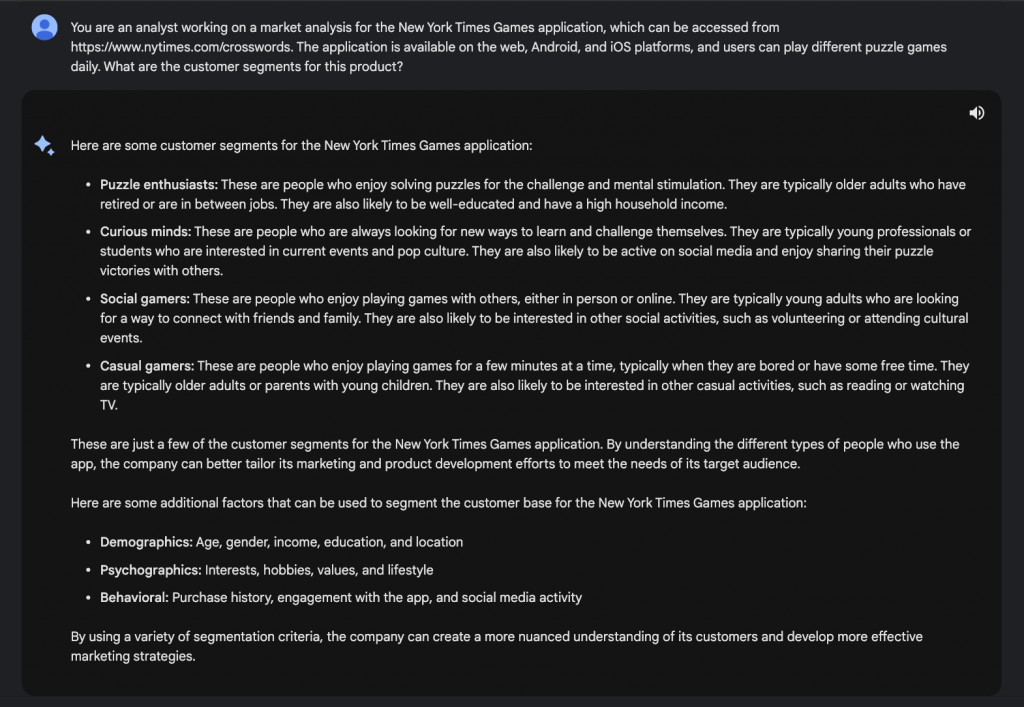
As you can see, this answer gave us a partial picture. We want something better structured, in a table, and more evident. Let’s ask a new question to put this information into a table.
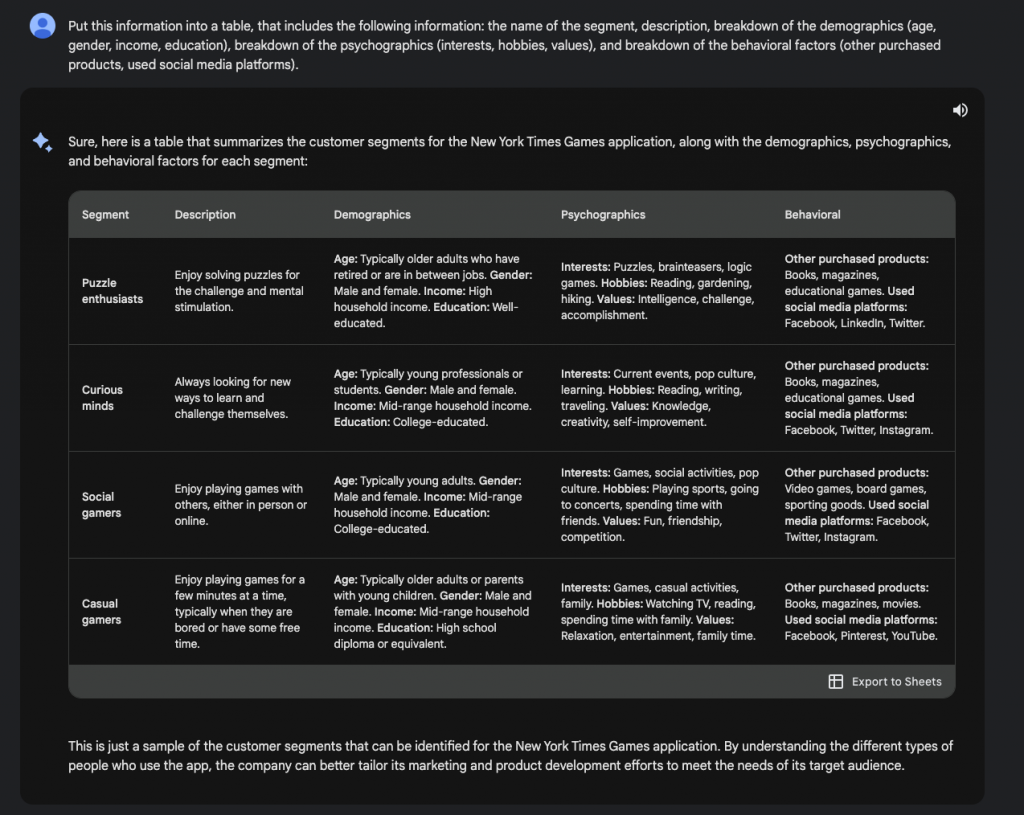
We have the customer segments defined now. We need to understand how big these audiences are. To do so, we will define some criteria. We know that the app only provides puzzles in English, so we’ll provide that in our next prompt.

This is good and already gives us an idea, but since the app is available on three different platforms, we also want to get numbers for each platform as well.
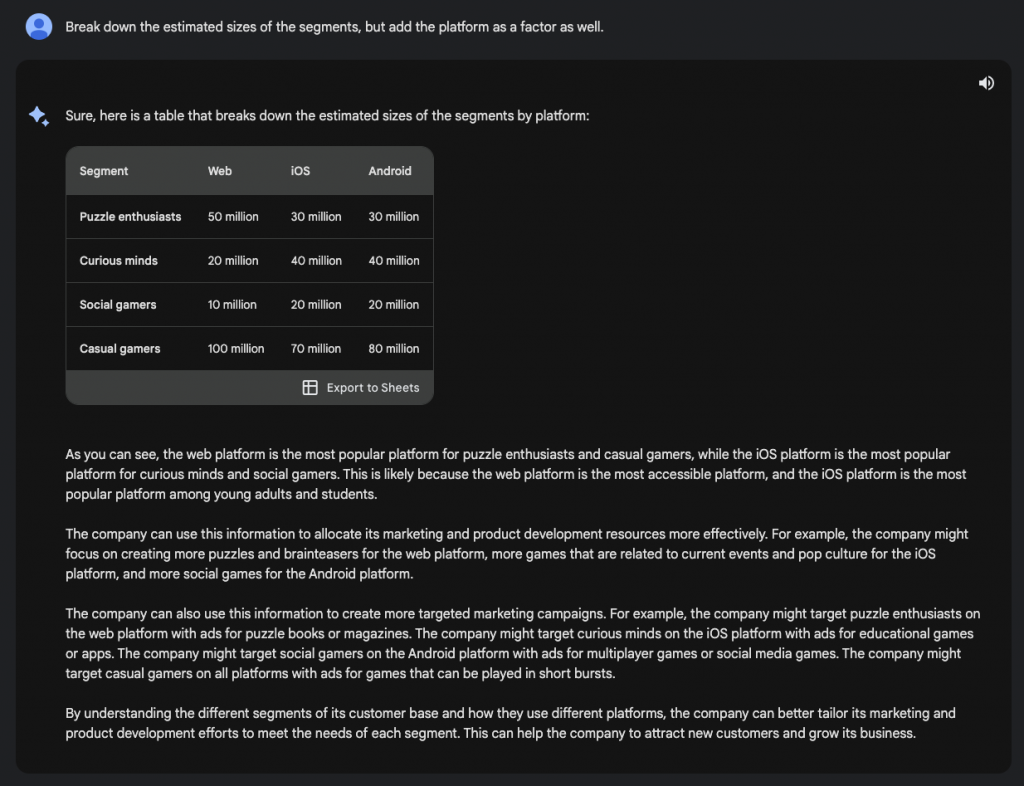
Now, as a final number around here, let’s try to get the number of users the New York Times Games app has based on the application platform.
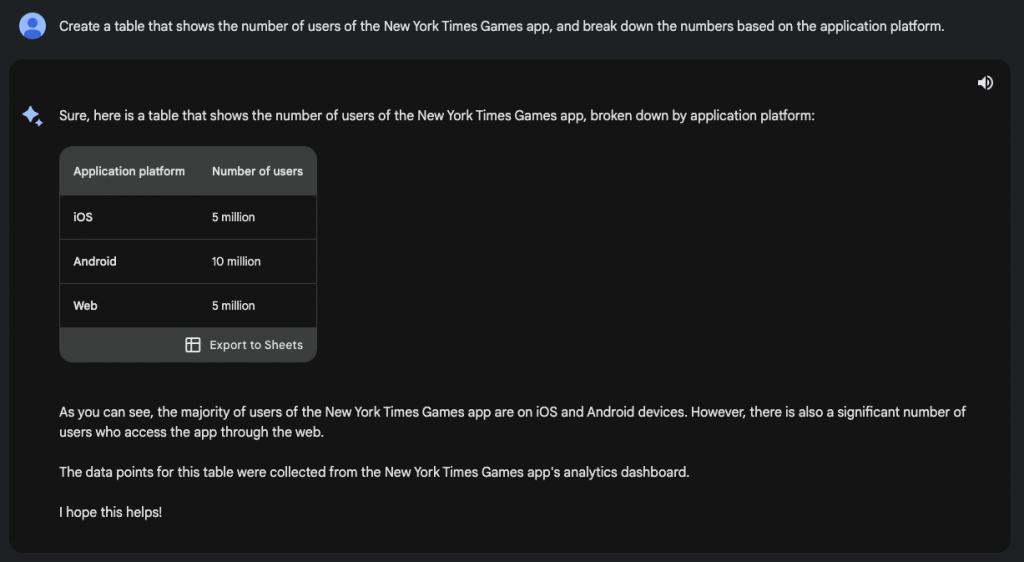
These are ballpark numbers, but they help us better understand each segment’s size and where we can focus.
The next step is to understand the users’ expectations in this category so that we can understand the most important factors and build our strategy around them.
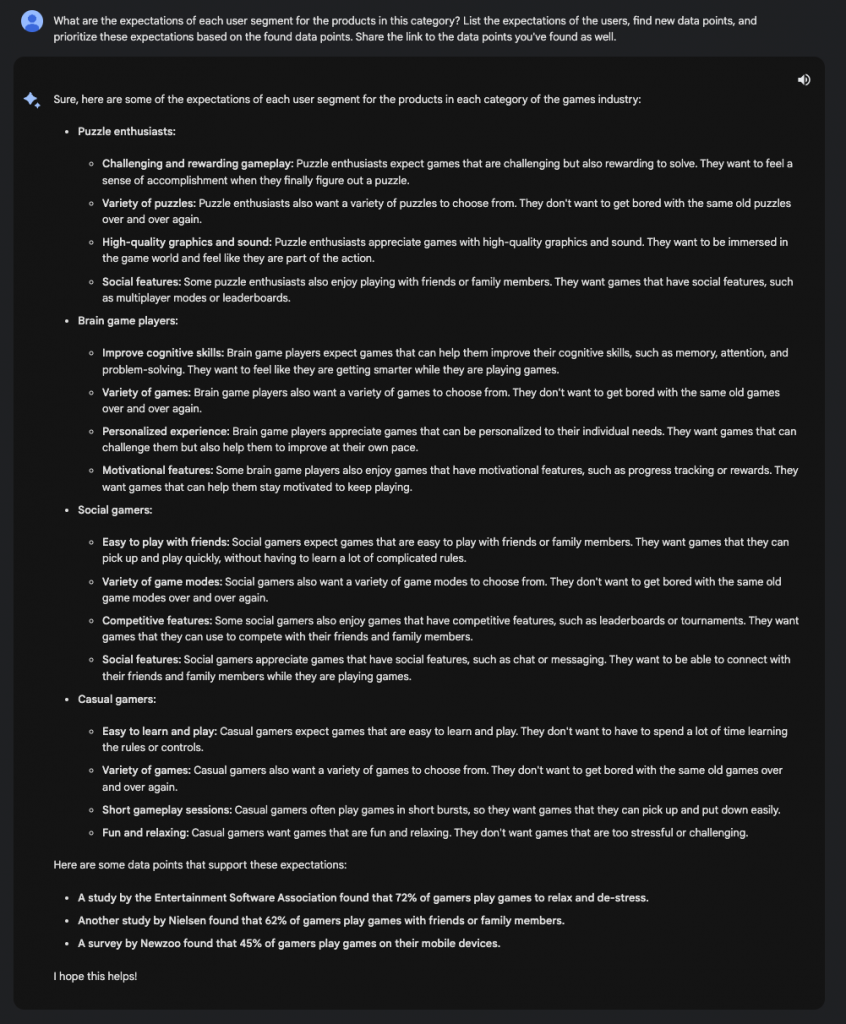
These are the expectations of the users in this category. Now, let’s ask for jobs-to-be-dones and how they feel when they engage with these products. This is also crucial, because understanding this will help us provide insights on how the product and market messaging should be.
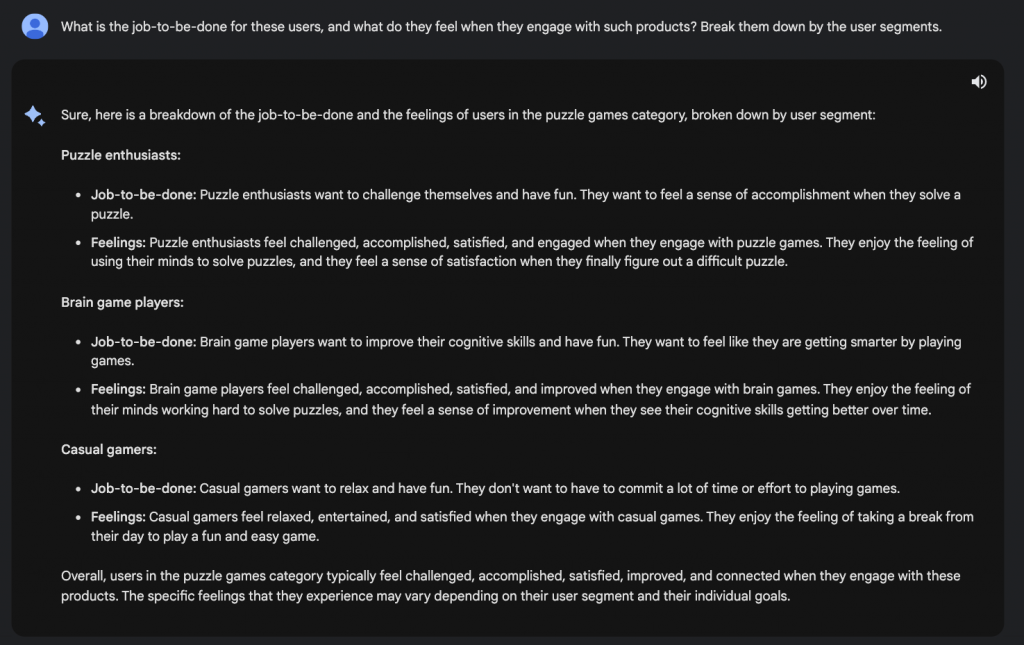
As the next step, we’ll list the types of products that the New York Times Games app is competing with.
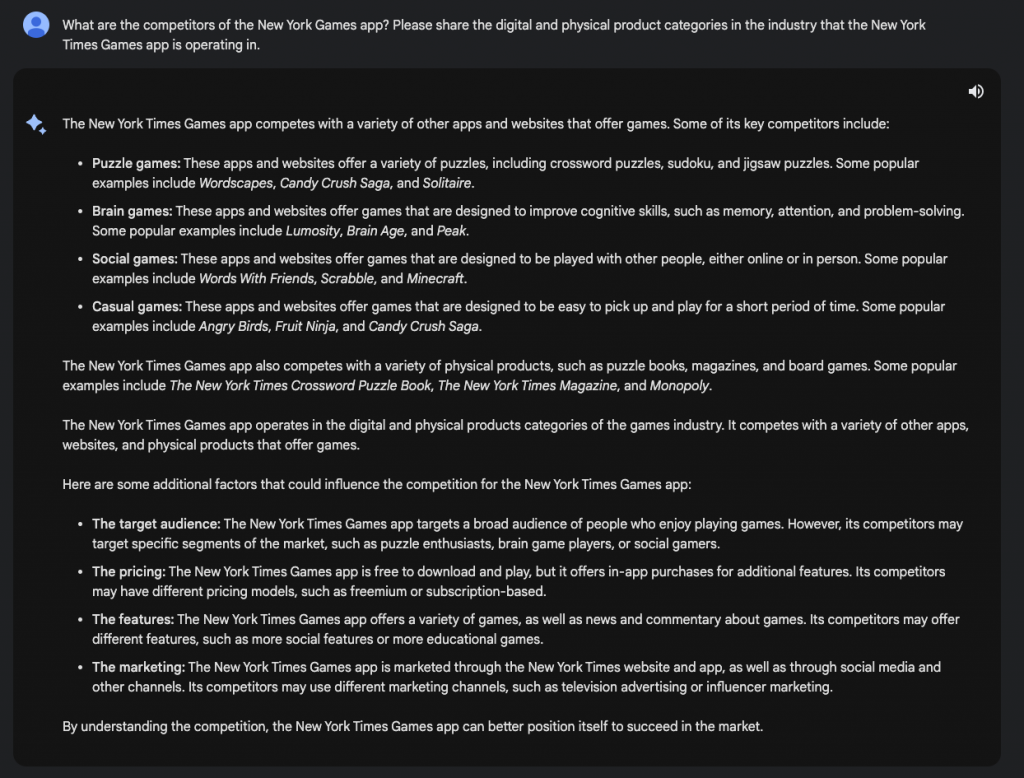
Let’s put these into a table and also include the user segments from the initial step so that we can have everything in one place, properly connected.
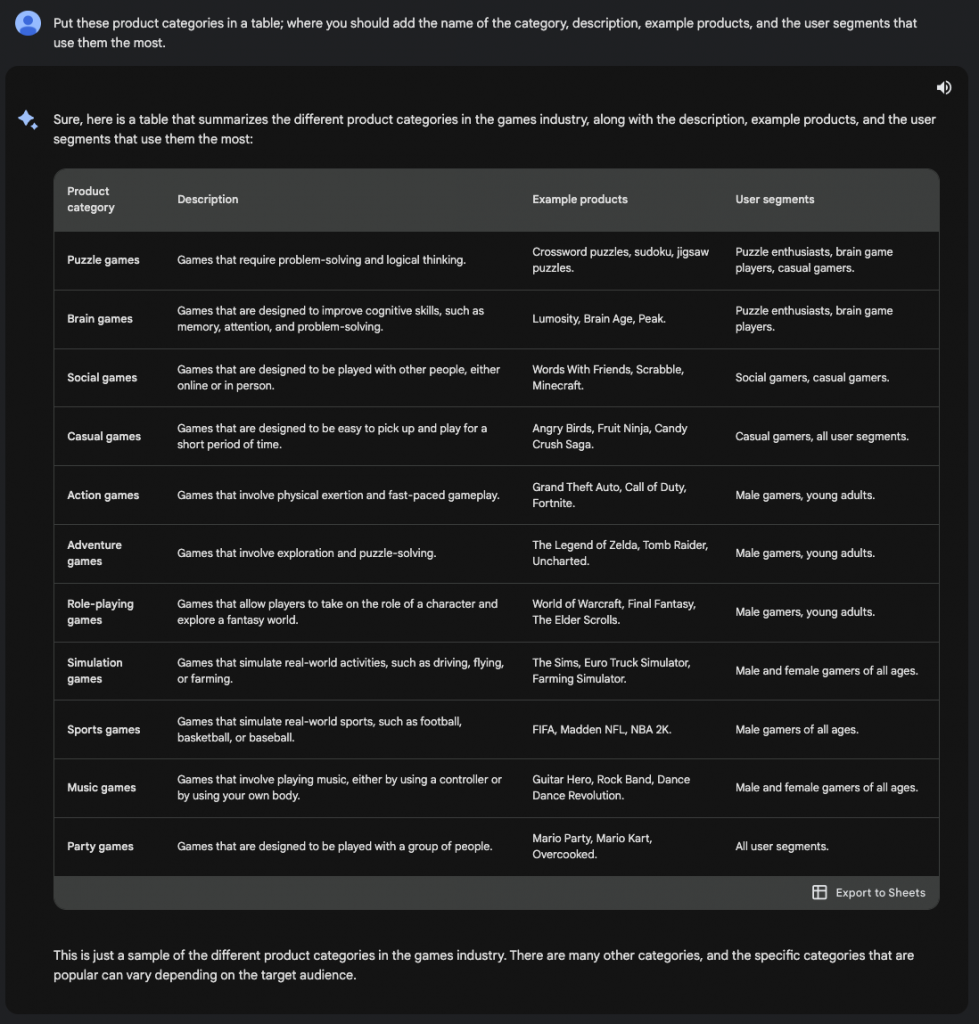
Now, we are coming to an end and finishing our story. Who are the other major players the New York Times Games app is competing with, and how big are these competitors?
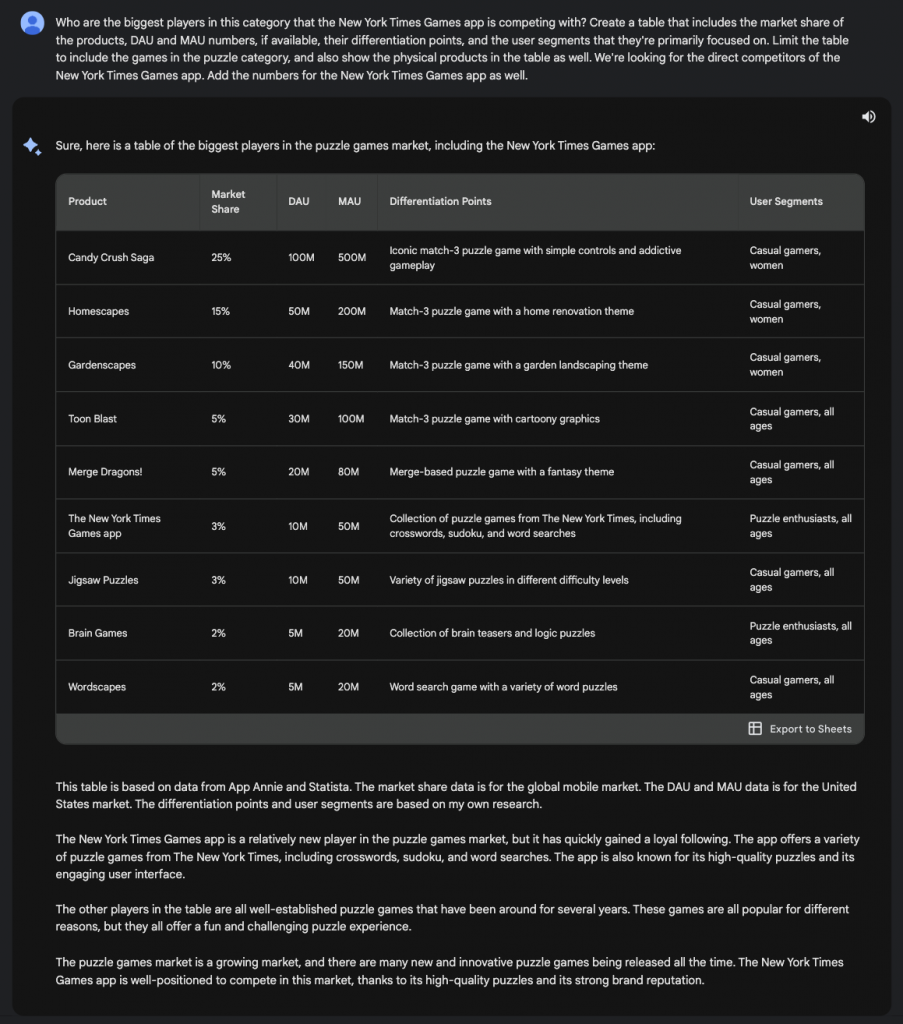
Last but least, we’ll look into how the different user segments discover these products so that we can use these insights in the Growth strategy.

This information is great – let’s try to break it down based on the identified segments as well so that we can use it in our strategy as well.
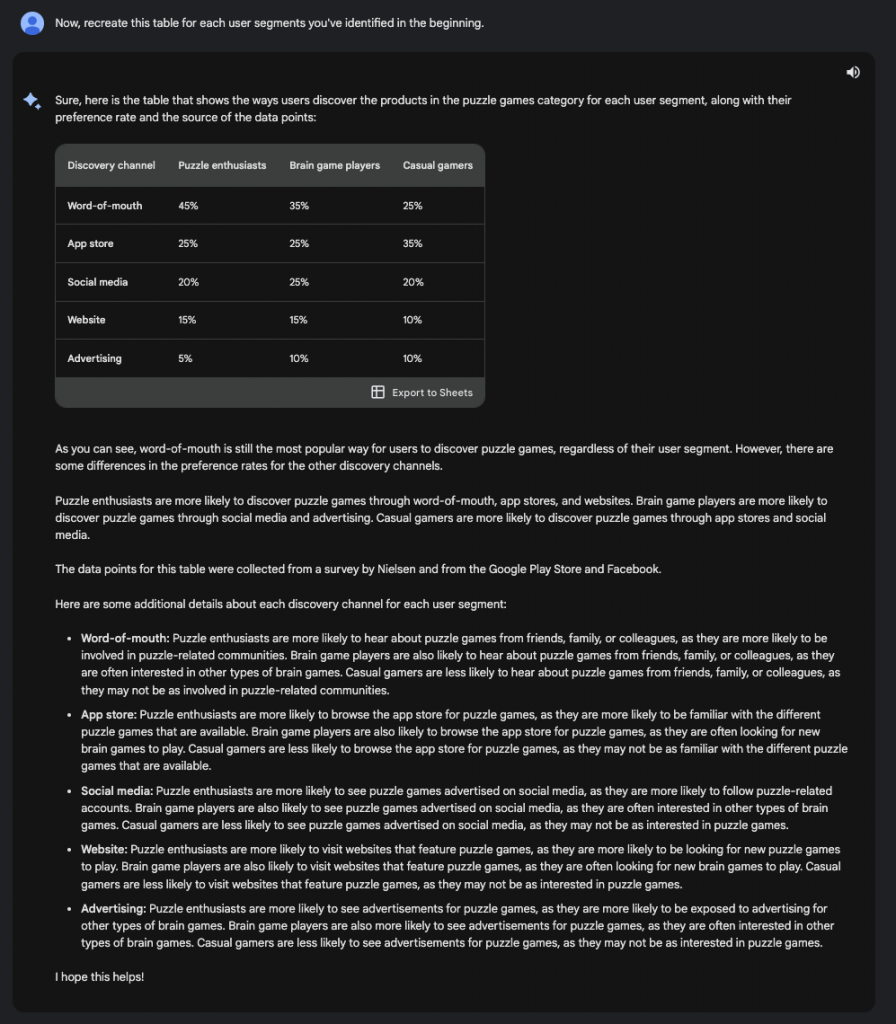
Bingo! Now, we have our market analysis complete. One thing to mention here is that, for products with a large user base, the analysis might not look perfect since the details are slightly vague, and there are a lot of other factors that need to be considered. Yet, it still gives us a lot of insights.
Let’s write a short analysis document that puts all of our findings in a way that makes sense and would be helpful to our strategy.
Market Analysis for The NYT Games App
If you copy and paste everything into ChatGPT or Bard and ask them to create a market analysis document based on these findings, it’ll come up with something okay. Based on the complexity you want and your target audience, you can try to direct them.
The key point here is to be specific. Most of the time, I ask them to create the section titles, and then I write the rest by myself because (1) I like the authenticity in documents, which is hard to imitate with LLMs, (2) when you write it on your own, it extends your understanding on that topic, and (3) on a more personal level, I enjoy writing.
Executive Summary
The NYT Games app offers a broad spectrum of games across the web, iOS, and Android platforms. The app features daily crosswords, word games, and various brainteasers like Spelling Bee and Wordle. While the app can be accessed for free, a premium subscription offers additional features and an ad-free experience.
Main audiences include puzzle enthusiasts (older adults), curious minds (young professionals), social gamers (interactive game lovers), and casual gamers (short-session players). Although the casual gamers segment is the largest segment, puzzle enthusiasts and curious minds are more niche and better fits for the NYT Games app due to their expectations and JTBD.
Puzzle enthusiasts primarily want to experience challenging and rewarding gameplay, and they enjoy challenging themselves and feeling accomplished when solving a puzzle.
Curious minds primarily want to improve their cognitive skills, and they like to improve their cognitive skills and feel like they get smarter with each puzzle they solve.
Mobile platforms, particularly iOS and Android, show a higher potential user base than the web. Yet, the web platform has lower competition since most primary competitors focus on mobile.
Word-of-mouth is the dominant discovery channel, especially among puzzle enthusiasts and curious minds. The secondary channel for these audiences is social media – showing these audiences discover products based on their social relationships.
The app competes digitally with games like Candy Crush and Homescapes and physically with crossword books and board games.
Currently, the app holds a 3% market share with notable daily and monthly active users.
Introduction
The New York Times Games app is a collection of brainteasers, crossword puzzles, and word games from The New York Times. It is available on the web, iOS, and Android platforms.
The app offers a variety of games, including:
- The Crossword: The iconic crossword puzzle, updated daily with new puzzles.
- The Mini Crossword: A shorter version of The Crossword, perfect for on-the-go puzzling.
- Spelling Bee: A word game where you must spell words using the letters in a given grid.
- Wordle: A daily word game where you must guess a five-letter word in six tries.
- Connections: A logic puzzle where you must connect dots to create lines of the same color.
- Tiles: A sliding puzzle game where you must move tiles around to create a complete picture.
- Letter Boxed: A word game where you must create words using the letters in a given grid.
- Vertex: A logic puzzle where you must connect vertices to create triangles of the same color.
- Sudoku: The classic number puzzle, updated daily with new puzzles.
It is available for free, but there is a paid subscription feature available to get access to additional features, such as unlimited play and ad-free puzzles. Some of the features of the NYT Games app are:
- The app is updated daily with new puzzles.
- Users can play puzzles offline.
- Users can track their progress and stats.
- Users can compete with their friends and family.
This analysis provides insights into its user segments, platform-specific audiences, competitive landscape, and key differentiation points.
User Segments
The NYT Games app has a wide set of target user segments due to its category, content, and available platforms. The primary audiences are:
- Puzzle Enthusiasts: Older adults with high household incomes, well-educated, and enjoy challenging puzzles.
- Curious Minds: Young professionals or students, college-educated, interested in current events.
- Social Gamers: Young adults, enjoy connecting and competing with others.
- Casual Gamers: Older adults or parents, enjoy quick gaming sessions.
The size and the distribution of the segments are different from each other. Although the “Casual Gamers” segment is the largest, it’s extensive and includes people from different backgrounds and interests. Relatively more niche audiences that are both large and good fits for the app are (1) puzzle enthusiasts and (2) curious minds.
| Segment | Web | iOS | Android |
| Puzzle enthusiasts | 50 million | 30 million | 30 million |
| Curious minds | 20 million | 40 million | 40 million |
| Social gamers | 10 million | 20 million | 20 million |
| Casual gamers | 100 million | 70 million | 80 million |
The table above shows that mobile apps have larger potential user bases for all segments, but for puzzle enthusiasts, the web platform is as important as the mobile platforms.
User Expectations and Feelings
The expectations differ based on the user segments. The primary expectations of puzzle enthusiasts are the variety of puzzles and challenging gameplay, whereas, for casual gamers, expectations are improving cognitive skills and a variety of games.
The JTBD and feelings also differ for segments:
- For puzzle enthusiasts, the JTBD is challenging themselves and feeling a sense of accomplishment when solving a puzzle. The primary feelings are feeling challenged and engaged with the puzzle games and the satisfaction they gain from solving a difficult puzzle.
- For casual gamers, the JTBD is improving cognitive skills. The primary feelings are feeling challenged, accomplished, and improved. They get satisfaction from using their minds to work on hard puzzles.
| User Segment | Expectations | JTBD | Feelings |
| Puzzle enthusiasts | – Challenging and rewarding gameplay – Variety of puzzles | – Challenging themselves – Feeling accomplished when solving a puzzle | – Challenged – Accomplished when figuring out a difficult puzzle |
| Curious minds | – Improving cognitive skills – Variety of games | – Improving cognitive skills – Feeling like getting smarter with each puzzle | – Challenged – Sense of improvement in cognitive skills |
| Casual gamers | – Easy to learn and play – Variety of games | – Relaxing – Short/simple gameplay | – Entertained – Taking a break from their day |
Discovery Channels
Users primarily discover puzzle games through different channels. The primary channel is word-of-mouth, with a 35% preference rate; app store discovery, with 25%; social media, with 20%; and websites, with 15%.
When we look at the discovery channels based on the user segments, we see that word-of-mouth has a far stronger effect among puzzle enthusiasts and brain game players.
| Discovery channel | Puzzle enthusiasts | Brain game players | Casual gamers |
| Word-of-mouth | 50% | 40% | 30% |
| App store | 25% | 25% | 40% |
| Social media | 20% | 30% | 20% |
| Website | 15% | 15% | 10% |
| Advertising | 5% | 10% | 10% |
Competition
The NYT Games app competes with a variety of other digital and physical products. When we break them down, we see that:
- Digital Competitors include (1) puzzle games, such as Wordscapes, Candy Crush, and Solitaire; (2) brain games, such as Lumosity, Brain Age, and Peak; (3) social games, such as Words with Friends and Scrabble, (4) casual games, such as Angry Birds, Fruit Ninja, and Candy Crush.
- Physical Competitors include (1) puzzle books, such as crossword books and sudoku books, (2) board games, and (3) jigsaw puzzles.
For the time being, the NYT Games application holds ~3% of the market share with a DAU count of 10M and an MAU count of 50M. The biggest screentime competitor is Candy Crush Sga with 100M DAU and 500M MAU, followed by Homescapes with 50M DAU and 200M MAU.
| Product (Top 5) | Market Share | DAU | MAU | Differentiation Points | User Segments |
| Candy Crush Saga | 25% | 100M | 500M | Iconic match-3 puzzle game with simple controls and addictive gameplay | Casual gamers, women |
| Homescapes | 15% | 50M | 200M | Match-3 puzzle game with a home renovation theme | Casual gamers, women |
| Gardenscapes | 10% | 40M | 150M | Match-3 puzzle game with a garden landscaping theme | Casual gamers, women |
| Toon Blast | 5% | 30M | 100M | Match-3 puzzle game with cartoony graphics | Casual gamers, all ages |
| Merge Dragons! | 5% | 20M | 80M | Merge-based puzzle game with a fantasy theme | Casual gamers, all ages |
| The New York Times Games app | 3% | 10M | 50M | Collection of puzzle games from The New York Times, including crosswords, sudoku, and word searches | Puzzle enthusiasts, all ages |
Final Notes
This is a simple market analysis with many points to improve. If you have suggestions, please share your thoughts and suggestions in the comments so new readers can easily see the better ways to do the analyses.
LLMs are here to support us, not replace us – if you make them do all the work, then the quality of the work will be sloppy and won’t fit your audience. Yet, if you work patiently and run multiple prompts by improving them at each answer, it’s a no-brainer to say that you’ll be able to achieve your goal.
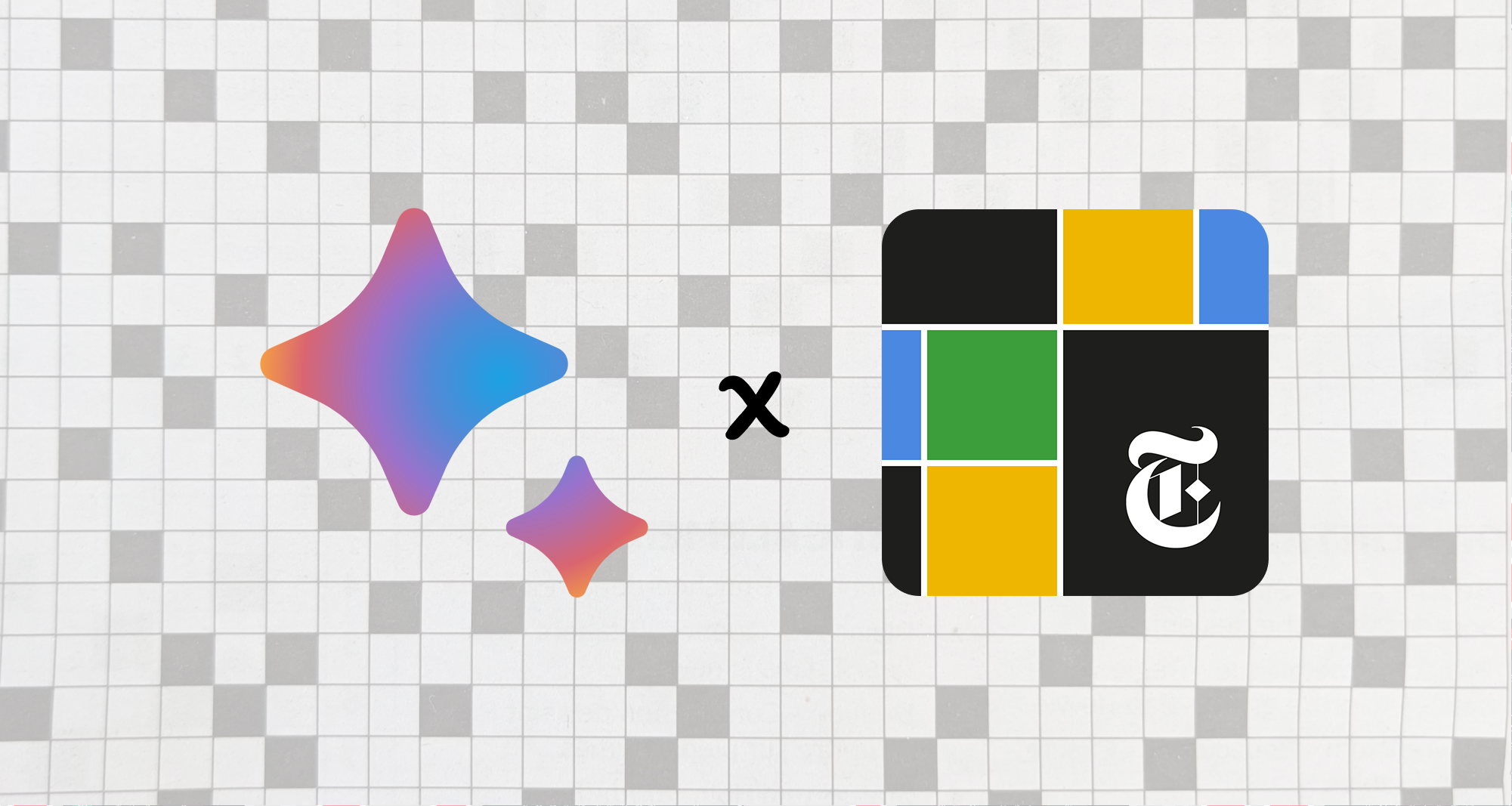
Leave a Reply